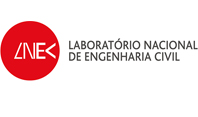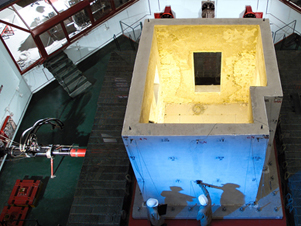LNEC-3D Shaking Table
> Go to LNEC-3D Shaking Table website
The infrastructure has a 5.6mx4.6m 3D shaking table (LNEC-3D), to which access is offered, located in a large testing hall with 10m height and an overhead crane with 400kN capacity, resulting in a versatile test facility that can be used for a variety of earthquake and dynamic load tests.
The LNEC-3D shaking table (ST) has three independent translational degrees of freedom, with the rotational ones being passively restrained via a stiff torque tube system. The actuators allow for dynamic forces of 1000kN in the vertical and 700kN in the horizontal directions to be applied to the system, with peak velocities up to 0.7m/s and peak displacements of 0.2m in all directions.
The control of the ST is fully digital, allowing input displacements of any form in a frequency range of 0-40Hz.
The digital control hardware and software was upgraded in 2011 into a more advanced and open platform, whereby the introduction of new control strategies or the implementation of new test strategies (e.g., hybrid simulations) is facilitated. The acquisition system allows a large number of physical variables (such as pressures, forces, accelerations, displacements, strains, etc.) to be monitored, using the extensive instrumentation available or specially developed instrumentation. The possibility of performing digital image processing for motion tracking using a set of synchronized fast megapixel cameras is under development.
The LNEC-3D ST was designed specifically for testing structures and components up to collapse or near-collapse conditions. It has a large capacity in terms of payload (max. weight of 40 tonnes), allowing tests on medium-sized structures or larger structures at reduced scale. A special feature of this installation is that the ST is surrounded by three stiff reaction walls, which can be used for different test setups. As an example, substructuring tests may be performed by introducing additional actuators between the reaction walls and the model on the ST, in order to simulate the dynamic reaction of a numerical substructure on the physical model.
Services currently offered by the infrastructure: This facility has participated in a large number of European and National R&D&I projects, namely offering transnational access since EU R&D&I FP2. Tests performed therein include: development and qualification of construction systems in reinforced concrete, steel, masonry or wood; seismic response control systems; geotechnical tests using a laminar box; retrofitting schemes; sustainable construction materials.
Experimental tests are often complemented with the development and calibration of numerical models and with the experimental assessment of the structural vulnerability. There is also a long tradition of developing experimental methods and instrumentation devices, used for structural health monitoring or for substructuring tests. As a measure of the widespread interest in using this facility, there will be five international users performing ST tests at the facility in 2016.
The services provided to users of the infrastructure are: a) Assistance in the definition and design of the test model and experimental setup; b) Fabrication of test models, including automatic controlled sand pouring for geotechnical models; c) Preliminary destructive or non-destructive tests for identification of material properties; d) Assistance in the design, calibration and implementation of instrumentation, providing state-of the-art sensors, materials and components and the necessary workmanship; e) Data acquisition systems; f) Assistance in the definition of input signals; g) Use of analytical tools to support the design of the specimen and the test campaign; h) Photographic and video records of the test campaign; i) Data processing, analysis and interpretation of test results, namely using techniques for modal assessment and system identification; j) A computer network with access to advanced computer codes for static and dynamic analysis of structures; k) A data repository web portal, where all test results will be made available to the general public; and l) Training in topics specific to users’ interest and to the project to which experimental access is offered.



